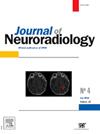急性缺血性卒中机械取栓术中的医源性栓塞:支架取栓技术与接触抽吸的比较。回顾性病例对照研究
IF 3.3
3区 医学
Q2 CLINICAL NEUROLOGY
引用次数: 0
摘要
机械取栓(MT)是治疗大血管闭塞(LVO)所致急性缺血性脑卒中的有效方法。虽然MT后栓塞到新区域(ENT)的记录很好,但同一远端区域(EDT)的栓塞数据有限。与mTICI 2b/2c相比,实现mTICI 3再灌注具有显著的临床益处,因此需要采取减少耳鼻喉和EDT的策略。先前的研究表明,与接触吸入者相比,接触吸入者的edt发病率更高。然而,临床实践中全面的比较研究很少。本研究比较了这些MT策略之间的总血栓栓塞率(OCE)。方法2015年1月至2019年11月在法国四所大学医院进行回顾性、多中心观察性研究。成人患者(?18岁)因LVO引起的急性缺血性中风,采用接触抽吸(ADAPT -直接抽吸第一次通过技术)或抽吸器治疗,特别是使用Embotrap装置保持样品均匀性。使用数字减影血管造影(DSA)进行成像,由两名独立的盲法评论者评估首次MT通过后的OCE。采用倾向得分完全匹配和独立样本检验来评估首次MT通过后的OCE。结果在纳入研究的206例患者中,每个治疗组103例,149例(72.7%)患者达到mTICI评分?第一次取栓后2a。在这些再灌注患者中,89例(59.7%)发生栓塞,要么发生在相同的远端区域(EDT),要么发生在新的区域(ENT)。根据考虑关键混杂因素的倾向评分分析,观察到接触抽吸和吸气技术之间OCE率的显著差异,与ADAPT相比,吸气技术导致的栓塞事件更少。(图1)结论与接触抽吸相比,采用扩压器技术可显著减少栓塞事件。这些结果表明,就LVO干预的栓塞风险而言,施压器方法可能提供更安全的配置文件,当栓塞风险是主要关注时,应考虑接触性抽吸,同时考虑个体患者因素。本文章由计算机程序翻译,如有差异,请以英文原文为准。
Iatrogenic emboli during mechanical thrombectomy for acute ischemic stroke : comparison betweek stent retriever technique and contact aspiration. A retrospective case-control study
Background
Mechanical thrombectomy (MT) is an effective treatment for acute ischemic stroke from large vessel occlusion (LVO). While embolization to a new territory (ENT) after MT is well-documented, data on embolization in the same distal territory (EDT) are limited. Achieving mTICI 3 reperfusion presents significant clinical benefits over mTICI 2b/2c, necessitating strategies to reduce both ENT and EDT. Previous studies suggest higher rates of EDTs with contact aspiration compared to stentrievers. However, comprehensive comparison studies in clinical practice are scarce. This study compares the rates of overall clot emboli (OCE) between these MT strategies.
Methods
A retrospective, multicenter observational study was conducted at four University Hospitals in France from January 2015 to November 2019. Adult patients (?18 years) with acute ischemic stroke due to LVO, treated with either contact aspiration (ADAPT - Direct Aspiration First Pass Technique) or stentrievers, specifically using the Embotrap device to maintain sample homogeneity, were included. Digital subtraction angiography (DSA) was used for imaging, with two independent, blinded reviewers assessing OCE post-first MT pass. Propensity score full matching and independent sample testing were employed to evaluate OCE after the first MT pass.
Results
Among the 206 patients included in the study, with 103 in each treatment group, 149 patients (72.7%) achieved a mTICI score ? 2a after the first pass of thrombectomy. Of these reperfused patients, 89 (59.7%) experienced emboli, either in the same distal territory (EDT) or in a new territory (ENT). A significant difference in OCE rates was observed between contact aspiration and stentriever techniques, with the stentriever technique resulting in fewer embolic events compared to ADAPT, based on a propensity score analysis that accounts for key confounding factors. (Fig.1)
Conclusion
A statistically significant reduction in embolic events was observed with the stentriever technique compared to contact aspiration. These results suggest that the stentriever method may offer a safer profile in terms of embolic risk for LVO interventions, and should be considered over contact aspiration when embolic risk is a primary concern, while also considering individual patient factors.
求助全文
通过发布文献求助,成功后即可免费获取论文全文。
去求助
来源期刊

Journal of Neuroradiology
医学-核医学
CiteScore
6.10
自引率
5.70%
发文量
142
审稿时长
6-12 weeks
期刊介绍:
The Journal of Neuroradiology is a peer-reviewed journal, publishing worldwide clinical and basic research in the field of diagnostic and Interventional neuroradiology, translational and molecular neuroimaging, and artificial intelligence in neuroradiology.
The Journal of Neuroradiology considers for publication articles, reviews, technical notes and letters to the editors (correspondence section), provided that the methodology and scientific content are of high quality, and that the results will have substantial clinical impact and/or physiological importance.
 求助内容:
求助内容: 应助结果提醒方式:
应助结果提醒方式:


